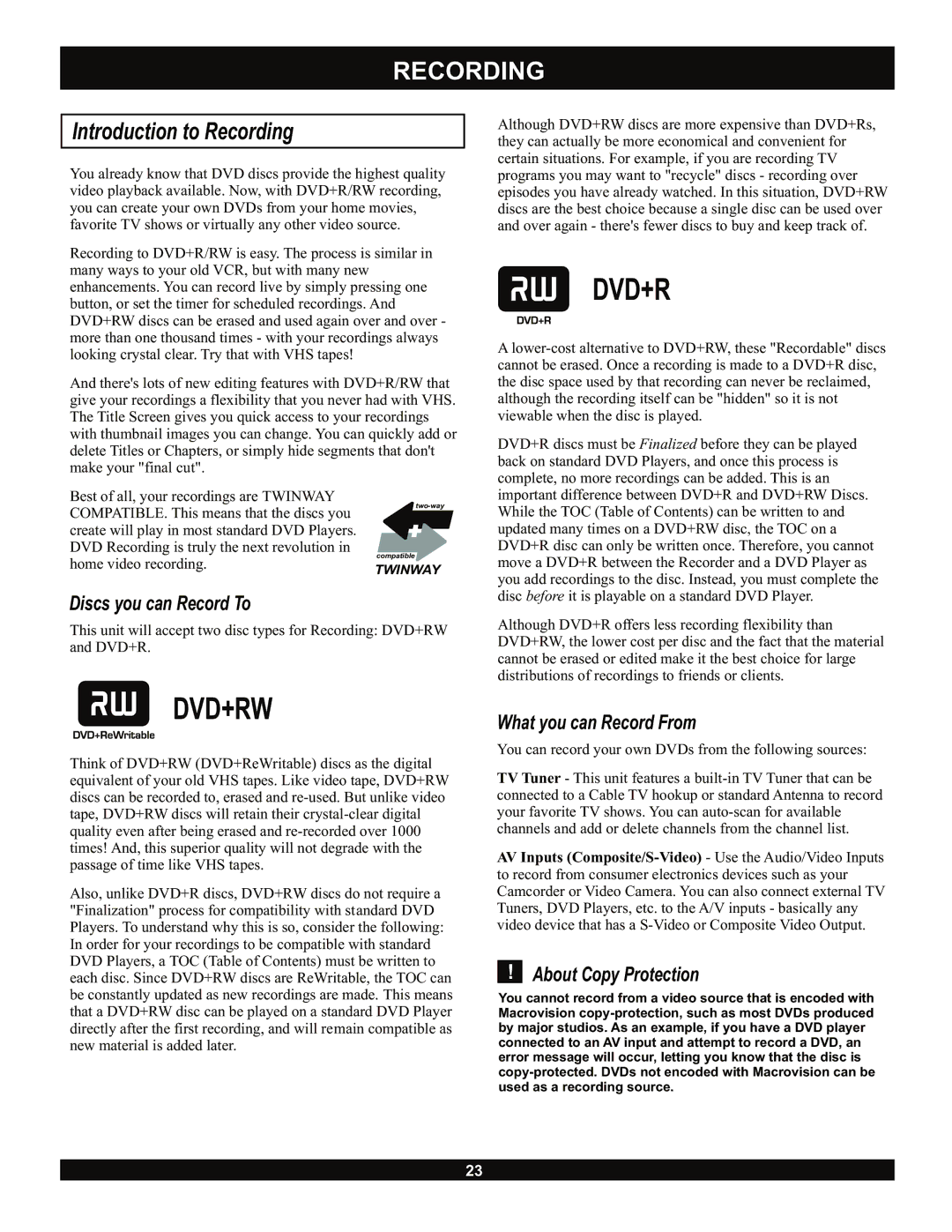
RECORDING
Introduction to Recording
You already know that DVD discs provide the highest quality video playback available. Now, with DVD+R/RW recording, you can create your own DVDs from your home movies, favorite TV shows or virtually any other video source.
Recording to DVD+R/RW is easy. The process is similar in many ways to your old VCR, but with many new enhancements. You can record live by simply pressing one button, or set the timer for scheduled recordings. And DVD+RW discs can be erased and used again over and over - more than one thousand times - with your recordings always looking crystal clear. Try that with VHS tapes!
And there's lots of new editing features with DVD+R/RW that give your recordings a flexibility that you never had with VHS. The Title Screen gives you quick access to your recordings with thumbnail images you can change. You can quickly add or delete Titles or Chapters, or simply hide segments that don't make your "final cut".
Best of all, your recordings are TWINWAY
COMPATIBLE. This means that the discs you create will play in most standard DVD Players. DVD Recording is truly the next revolution in
compatible
home video recording. | TWINWAY |
|
Discs you can Record To
This unit will accept two disc types for Recording: DVD+RW and DVD+R.
DVD+RW
Think of DVD+RW (DVD+ReWritable) discs as the digital equivalent of your old VHS tapes. Like video tape, DVD+RW discs can be recorded to, erased and
Also, unlike DVD+R discs, DVD+RW discs do not require a "Finalization" process for compatibility with standard DVD Players. To understand why this is so, consider the following: In order for your recordings to be compatible with standard DVD Players, a TOC (Table of Contents) must be written to each disc. Since DVD+RW discs are ReWritable, the TOC can be constantly updated as new recordings are made. This means that a DVD+RW disc can be played on a standard DVD Player directly after the first recording, and will remain compatible as new material is added later.
Although DVD+RW discs are more expensive than DVD+Rs, they can actually be more economical and convenient for certain situations. For example, if you are recording TV programs you may want to "recycle" discs - recording over episodes you have already watched. In this situation, DVD+RW discs are the best choice because a single disc can be used over and over again - there's fewer discs to buy and keep track of.
DVD+R
A
DVD+R discs must be Finalized before they can be played back on standard DVD Players, and once this process is complete, no more recordings can be added. This is an important difference between DVD+R and DVD+RW Discs. While the TOC (Table of Contents) can be written to and updated many times on a DVD+RW disc, the TOC on a DVD+R disc can only be written once. Therefore, you cannot move a DVD+R between the Recorder and a DVD Player as you add recordings to the disc. Instead, you must complete the disc before it is playable on a standard DVD Player.
Although DVD+R offers less recording flexibility than DVD+RW, the lower cost per disc and the fact that the material cannot be erased or edited make it the best choice for large distributions of recordings to friends or clients.
What you can Record From
You can record your own DVDs from the following sources:
TV Tuner - This unit features a
AV Inputs
!About Copy Protection
You cannot record from a video source that is encoded with Macrovision
23
